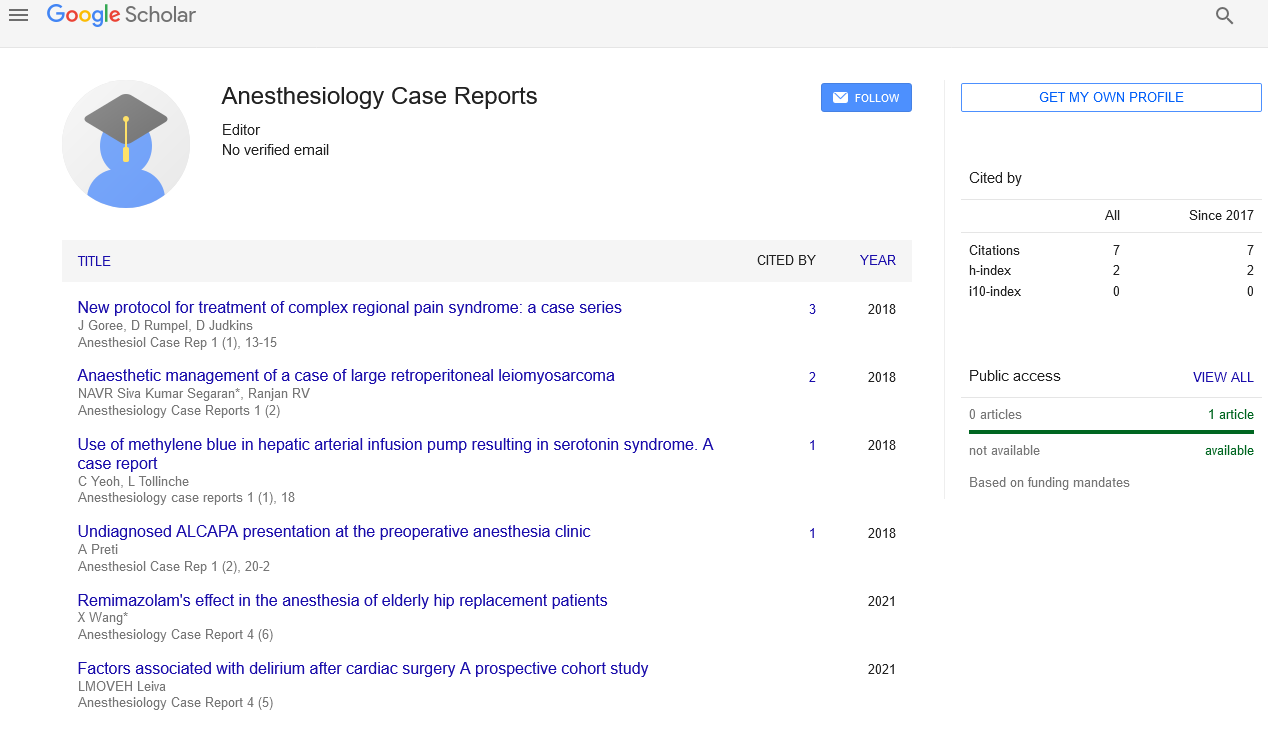Pulmonary aspiration of gastric content
Received: 11-Mar-2022, Manuscript No. pulacr-22-4967; Editor assigned: 14-Mar-2022, Pre QC No. pulacr-22-4967 (PQ); Reviewed: 21-Mar-2022 QC No. pulacr-22-4967 (Q); Revised: 24-Mar-2022, Manuscript No. pulacr-22-4967 (R); Published: 28-Mar-2022, DOI: 10.37532. pulacr.22.5.2.04
This open-access article is distributed under the terms of the Creative Commons Attribution Non-Commercial License (CC BY-NC) (http://creativecommons.org/licenses/by-nc/4.0/), which permits reuse, distribution and reproduction of the article, provided that the original work is properly cited and the reuse is restricted to noncommercial purposes. For commercial reuse, contact reprints@pulsus.com
Abstract
Gastric content pulmonary aspiration is a dangerous anaesthetic event that can result in considerable morbidity and mortality. Fasting times are commonly used to estimate the risk of aspiration. Fasting guidelines, on the other hand, do not apply to emergency or emergent situations or to patients. Certain co-morbidities are present. The measurement of gastric content and volume is a new point-of-care procedure. An ultrasound application that can assist in determining the danger of aspiration.
Keywords
Gastric aspiration; ultrasonography; pulmonary aspiration
Introduction
Gastric aspiration during surgery is a rare but significant anaesthetic complication. In a mixed surgical population, the total incidence varies between 0.1 % and 19 %, depending on patient and operative circumstances, and has not altered in recent decades. Aspiration pneumonia is linked to severe morbidity, including extended mechanical ventilation, and has a mortality rate of up to 5%. Up to 9% of all anaesthesia-related deaths are caused by pulmonary aspiration.
For more than two decades, gastroenterologists have employed gastric ultrasonography to measure stomach motility and emptying, as well as to diagnose gastric wall lesions such as cancer [1]. After a standardised solid– liquid meal, sequential ultrasonography measurements of antral CSA at defined time intervals have been described. Gastroenterologists have utilised this method to evaluate gastric emptying time and motility, and it has been demonstrated to be quite similar to scintigraphy, a more invasive gold standard that uses radioactive material. However, bedside ultrasound has only lately been utilised to quantify stomach content and volume in order to estimate perioperative aspiration risk and guide anaesthetic management.
As a new diagnostic tool, stomach sonography must be evaluated for validity (does it accurately assess what it claims to test), reliability (are the results repeatable), and interpretability (what are the clinical implications of specific findings). The majority of research to date have looked at validity issues and concluded that bedside ultrasonography accurately determines GV [2]. Despite the fact that numerous descriptions of the kind of content (e.g., empty, clear fluid, solid) have been published, the sensitivity and specificity of a qualitative test (i.e., how well can we distinguish between different forms of content) have yet to be thoroughly investigated [3].
As more data on the validity (accuracy) and reliability (reproducibility) of stomach sonography becomes available, the next big challenge is how to appropriately integrate this novel diagnostic tool into daily clinical practise to assess aspiration risk and adapt anaesthesia care in appropriate instances.
An empty stomach indicates a low risk of aspiration, which can only be verified qualitatively. As previously noted, solid, particle, or thick fluid content with a significant risk of aspiration can also be diagnosed using sonographic appearance [4].
The fundus is found in the abdomen’s left upper quadrant, inferior to the diaphragm, anterior to the left kidney, and posterior to the spleen. Due to its deep placement and the lack of a wide acoustic window due to the rib cage, it is the most difficult area of the stomach to picture. There have been two ways described. A low success rate has been recorded for a left lateral, intercostal, trans-splenic approach. A longitudinal scan in the midaxillary line has been utilised as an alternative. The presence of air in both the fundus and the body, even in ‘empty’ stomachs, makes vision of these two regions difficult [5].
Defining the minimum training requirements to enable accurate evaluations is one of several topics that needs more research. Furthermore, the majority of the data currently available is for adults. Volume assessment models, in particular, have only been validated in non-pregnant adult patients, and more research is needed in paediatric and obstetric patients. Furthermore, 3D and 4D ultrasonography are novel imaging modalities that could play a role in ultrasound stomach assessment in the future.
REFERENCES
- Smith I, Kranke P, Murat I, et sl. Perioperative fasting in adults and children: guidelines from the European Society of Anaesthesiology. Eur J Anaesthesiol. 2011 ;28(8):556-69.
Google Scholar Crossref - Jayaram A, Bowen MP, Deshpande S, et al. Ultrasound examination of the stomach contents of women in the postpartum period. Anesth Analg. 1997;84(3):522-6.
Google Scholar Crossref - Perlas A, Chan VW, Lupu CM, et al. Ultrasound assessment of gastric content and volume. J Am Soc Anesthesiol. 2009;111(1):82-9.
Google Scholar Crossref - Perlas A, Davis L, Khan M, et al. Gastric sonography in the fasted surgical patient: a prospective descriptive study. Anesth Analg. 2011;113(1):93-7.
Google Scholar Crossref - Fujigaki T, Fukusaki M, Nakamura H, et al. Quantitative evaluation of gastric contents using ultrasound. J Clin Anesth. 1993;5(6):451-5.
Google Scholar Crossref





